Choosing the right Burton snowboard boot size is crucial for comfort, performance, and overall riding experience. This guide helps you navigate Burton’s sizing system, ensuring a perfect fit whether you’re a seasoned rider or a beginner. Proper sizing enhances control and minimizes discomfort, making every session enjoyable.
Understanding Burton Snowboard Boot Sizing
Burton snowboard boots use the Mondopoint sizing system, ensuring consistent fit across all models. Sizes often match standard US shoe sizes, but variations exist between brands and styles. Proper sizing is key for optimal performance and comfort on the mountain.
2.1. Mondopoint Sizing System
The Mondopoint sizing system, used by Burton, is a global standard that measures foot length in centimeters for precise fit. This system eliminates confusion by directly correlating boot size to foot length, reducing errors in size conversion. Burton boots are designed to match this system accurately, ensuring consistency across all models.
Unlike traditional shoe sizing, Mondopoint focuses solely on foot length, making it a reliable method for determining boot size. Burton implements this system to cater to a wide range of foot shapes and sizes, ensuring a comfortable and performance-driven fit for every rider. By measuring foot length in centimeters, the Mondopoint system provides a universal sizing solution that transcends regional differences in shoe sizing.
Understanding the Mondopoint system is essential for selecting the correct Burton boot size. It ensures that riders can enjoy optimal comfort and responsiveness, whether carving down groomed trails or exploring backcountry terrain. This precise sizing method is a key reason why Burton boots are renowned for their fit and performance.
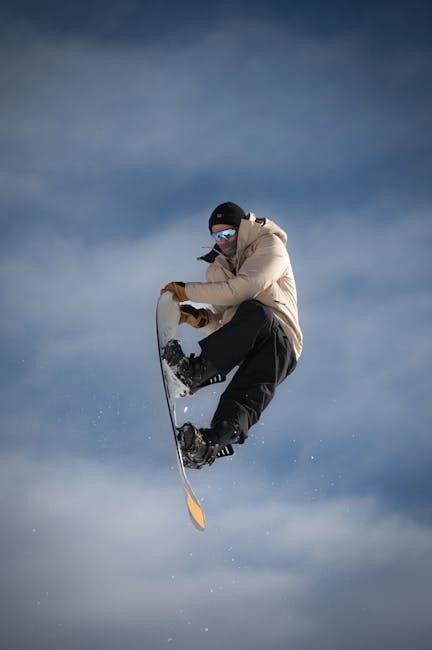
2.2. Differences Between Men’s, Women’s, and Kids’ Sizes
Burton snowboard boots are designed with specific fit characteristics for men, women, and kids, catering to the unique needs of each group. Men’s boots typically offer a roomier toe box and are built to accommodate larger foot lengths, while women’s boots are tailored for narrower, smaller foot shapes. Kids’ boots, including youth and toddler sizes, are scaled down to fit younger riders, with features like softer flex and easier lacing systems.
Men’s sizes generally range from US 7 to 15, with options for wide or slim fits to accommodate different foot widths. Women’s sizes start at US 5 and go up to 11, often with a more precise fit to ensure comfort for lighter riders. Kids’ sizes, including toddler options like size C, are designed for smaller feet and growing riders, ensuring a comfortable yet secure fit.
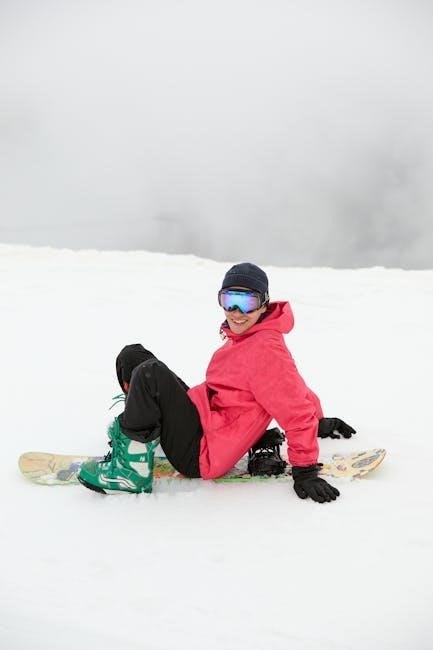
Understanding these differences is key to selecting the right boot for your needs. Burton’s size charts provide detailed guidance, helping riders of all ages and foot shapes find the perfect fit. By addressing the unique requirements of each group, Burton ensures that every rider can enjoy optimal comfort and performance on the mountain.
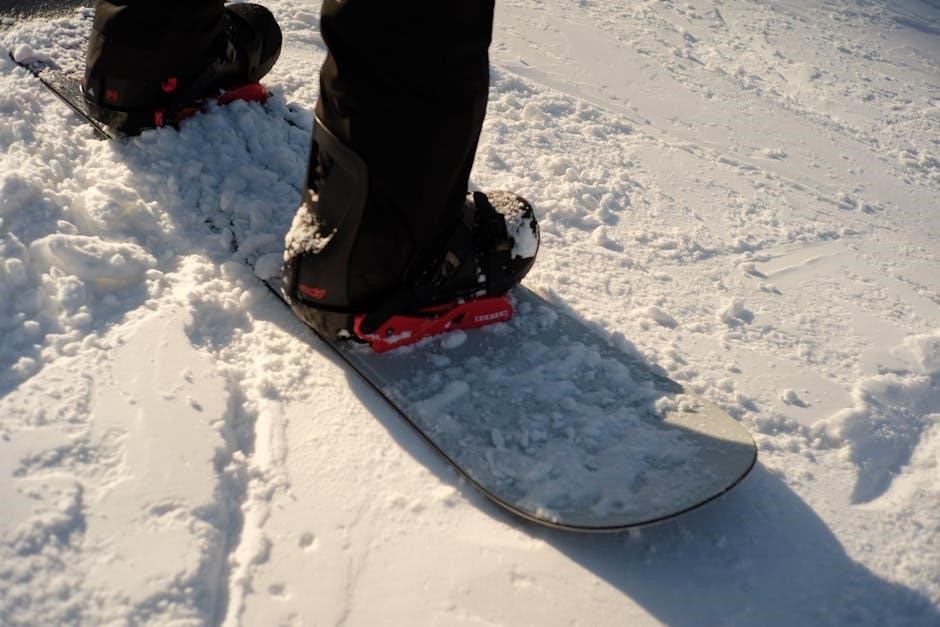
How to Choose the Right Size
To choose the right Burton snowboard boot size, measure your foot length, check the Mondopoint size chart, and convert your street shoe size. Ensure proper fit by considering your foot width and personal comfort preferences for optimal performance and all-day comfort.
3.1. Measuring Your Foot Length
Accurately measuring your foot length is the first step in finding the right Burton snowboard boot size. To do this, place your foot flat on the ground and use a ruler to measure from the back of the heel to the tip of your longest toe. This measurement will give you your foot length in centimeters, which aligns with Burton’s Mondopoint sizing system.
For the most precise measurement, wear the same type of socks you plan to use while snowboarding, as this can affect the fit. If possible, use a Brannock device or a shoe size chart to ensure accuracy. Once you have your foot length, compare it to Burton’s size chart to find your corresponding Mondopoint size.
Keep in mind that foot width also plays a role in fit, but for now, focus on your foot length as the primary factor. Accurate measurement ensures a boot that is neither too tight nor too loose, providing optimal comfort and performance on the mountain.
3.2. Converting Street Shoe Size to Snowboard Boot Size
Converting your street shoe size to Burton snowboard boot size requires understanding the differences in sizing systems. Burton uses the Mondopoint system, which measures foot length in centimeters, while street shoes often use different sizing standards. To convert, measure your foot length and compare it to Burton’s Mondopoint size chart.
Generally, Burton boots run true to size, but street shoe sizes can vary by brand. For example, if you wear a size 11 in street shoes, you may need a size 10.5 in Burton boots. This variation is due to differences in shoe last shapes and materials. To ensure accuracy, use your foot length measurement rather than relying solely on street shoe size.
When converting, consider that Burton’s sizing is precise to your foot length. If your street shoe size doesn’t match your Mondopoint size, trust the Mondopoint measurement for the best fit. Always try boots on with the socks you plan to wear snowboarding to ensure comfort and performance.
Remember, proper sizing is key to preventing discomfort and enhancing your riding experience. Use Burton’s size chart as your guide and adjust based on personal fit preferences.

Fit Considerations

Proper fit is essential for comfort and performance. Burton boots offer standard, slim, and wide options to suit different foot shapes. Ensure a snug, comfortable fit and try them on with snowboarding socks for optimal comfort and control.
4.1. Understanding Boot Fit Types (Standard, Slim, Wide)
Burton snowboard boots are available in three main fit types: Standard, Slim, and Wide. Each cater to different foot shapes and preferences, ensuring optimal comfort and performance. The Standard fit is ideal for average foot widths, offering a balanced feel that works for most riders. Slim fit boots are designed for narrower feet, providing a snug, responsive feel that minimizes excess material. Wide fit boots accommodate broader feet, offering extra room in the toe box while maintaining support. Understanding your foot shape and preferences is key to selecting the right fit type. Burton’s Mondopoint sizing ensures accuracy, but trying boots on with snowboarding socks is recommended for the best fit. Proper fit enhances control, responsiveness, and comfort, making it essential for an enjoyable riding experience. Riders with specific foot needs, such as wider or narrower feet, should prioritize their fit type to avoid discomfort and performance issues.
4.2. Importance of Proper Fit for Performance
A proper fit in Burton snowboard boots is essential for maximizing performance on the mountain. Boots that fit well provide consistent control, responsiveness, and comfort, allowing riders to perform at their best. A snug, accurate fit ensures that energy transfer from the rider to the board is efficient, making turns precise and effortless. Conversely, boots that are too tight or too loose can hinder performance, leading to discomfort, fatigue, and reduced control. Proper fit also minimizes the risk of hotspots and blisters, which can distract from the riding experience. Burton’s focus on ergonomic design and customizable features, such as adjustable lacing systems, helps riders achieve a dialed-in fit tailored to their foot shape and riding style. Whether carving groomers or exploring backcountry, a well-fitting boot enhances responsiveness, stability, and overall performance. Neglecting proper fit can lead to subpar experiences, making it a critical factor for riders of all levels. Investing time in ensuring the right fit pays off with improved skills and more enjoyable sessions on the snow.
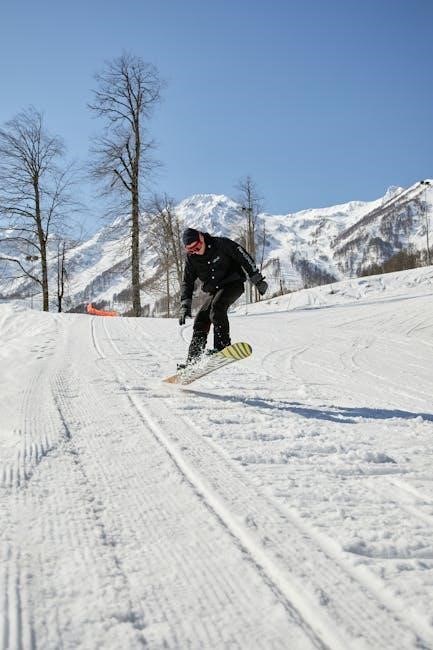
Trying On Burton Snowboard Boots
When trying on Burton snowboard boots, wear the same thin, moisture-wicking socks you’ll use snowboarding. Ensure a snug, comfortable fit with slight toe movement and no pressure points. Walk around to check for heel lift or discomfort, ensuring optimal support and responsiveness for your riding style.
5.1. What to Wear When Trying On Boots
When trying on Burton snowboard boots, it’s essential to wear the same type of socks you plan to use while snowboarding. Opt for thin, moisture-wicking socks to ensure an accurate fit and prevent blisters. Avoid thick or bulky socks, as they can misrepresent the boot’s true size and comfort.
Additionally, consider wearing the same base layers or snowboarding pants you’ll use on the mountain. This helps you assess how the boots fit with your typical snowboarding gear, especially if you plan to wear bulky clothing. If you use orthotics or custom insoles, bring them along to ensure the boots accommodate them comfortably. A proper fit is crucial for performance and comfort, so take the time to test the boots with the right attire.
Walk around the store to gauge how the boots feel when moving. Pay attention to any pressure points or heel lift, as these can indicate an improper fit. By dressing appropriately for the try-on, you can make a more informed decision and ensure your Burton boots provide the best possible experience on the slopes.
5.2. How to Test the Fit
Testing the fit of your Burton snowboard boots is crucial to ensure comfort and performance. Start by lacing the boots snugly but not overly tight, as this can restrict circulation. Make sure your heel stays firmly in place when you walk or shift your weight, with minimal heel lift. A proper fit should allow your toes to wiggle slightly without feeling cramped or pressured against the front of the boot.
Stand up and move around to assess how the boots feel when bearing weight. Check for any hotspots or pressure points that could lead to discomfort during extended use. If you plan to wear orthotics or custom insoles, ensure they fit comfortably inside the boot without altering the overall fit.
Pay attention to the flex of the boot. It should feel responsive but not stiff to the point of restriction. If the boot feels too tight or too loose, consider adjusting the size or trying a different model. Proper fit is essential for control, responsiveness, and all-day comfort on the mountain. By carefully testing the fit, you can ensure your Burton boots meet your needs for an optimal snowboarding experience.

Common Sizing Mistakes to Avoid
When selecting Burton snowboard boots, there are several common sizing mistakes to avoid for an optimal fit. One major error is relying solely on street shoe size without considering the differences in snowboard boot sizing systems. Many riders mistakenly assume their boot size will match their shoe size, but this can lead to poor fit due to variations in brands and styles. Another mistake is not accounting for the width of the boot, as Burton offers standard, slim, and wide fits. Ignoring the Mondopoint sizing system, which measures foot length in centimeters, can also result in improper sizing. Additionally, some riders fail to try on boots with the same type of socks they plan to wear, which can affect fit. Others overlook the importance of breaking in boots or testing the fit while laced up, leading to discomfort on the mountain. Lastly, assuming all Burton models fit the same way is a common oversight, as different lines may cater to specific foot shapes or riding styles. Avoiding these mistakes ensures a more accurate and comfortable fit.
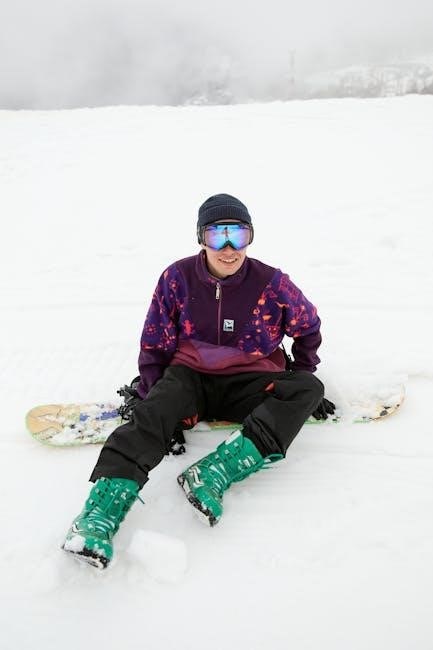
Additional Factors Influencing Boot Size
Beyond basic sizing, consider riding style, boot flex, and lacing systems, as they impact fit preferences. Foot width, personal comfort, and orthotic use also play roles. Breaking in boots gradually ensures comfort without compromising performance. These factors help refine size selection for optimal riding experience.

7.1. Riding Style, Boot Flex, and Lacing Systems
Your riding style significantly influences boot size and fit. Freestyle riders often prefer softer, more flexible boots for easier maneuverability, while all-mountain or powder riders may opt for stiffer boots for better control at high speeds. Boot flex ratings range from soft (1-2) to very stiff (9-10), and matching this to your riding style ensures optimal performance. Additionally, lacing systems like Burton’s Speed Zone or BOA can affect how the boot fits and performs. These systems allow for customizable tightness, which can compensate for size variations. Riders with wider feet may benefit from models with adjustable width or a roomier toe box. Personal comfort and how the boot responds during turns also play a role. Ensuring the boot flex aligns with your style prevents discomfort and enhances responsiveness. Ultimately, balancing riding style, flex, and lacing systems with proper sizing ensures a boot that performs well and feels great all day long.
7.2. Breaking In Your Boots
Breaking in your Burton snowboard boots is essential for optimal comfort and performance. While Burton boots are known for their out-of-the-box comfort, they may still require a short break-in period to mold to your feet. Start by wearing them around the house with the same socks you plan to use while riding. This helps the boots adapt to your foot shape and reduces the risk of discomfort on the mountain. For boots with heat-mouldable liners, consider visiting a professional fitter to ensure the best possible fit. If you prefer to do it yourself, wear the boots in a warm environment or use a hairdryer to gently heat the liners before moulding them to your feet. Avoid overheating, as this can damage the materials. The break-in process typically takes a few hours to a day, depending on the boot’s stiffness and your foot shape. Properly broken-in boots will provide better support, reduce foot fatigue, and enhance overall performance. Taking the time to break in your boots ensures a more enjoyable and comfortable snowboarding experience.
Choosing the right Burton snowboard boot size ensures comfort, performance, and an enjoyable riding experience. By understanding sizing systems, fit types, and personal preferences, you can make an informed decision. Proper fit enhances control and minimizes discomfort, making every session more enjoyable. Always consider breaking in your boots and seeking professional fitting for the best results.
8.1. Final Tips for the Best Fit
Ensuring the best fit for Burton snowboard boots involves a few key considerations. First, always try on boots with the same socks you plan to wear while snowboarding, as this affects fit. Pay attention to toe room—your toes should lightly brush the boot’s end without pressure. Heel fit is also critical; your heel should stay firmly in place to avoid blisters and improve control. If you’re between sizes, consider your riding style: tighter fits are better for responsiveness, while slightly roomier boots may be more comfortable for casual riders.
Break-in time is essential, especially for stiffer boots. Wear them around the house for a few hours before hitting the slopes to soften the material. Additionally, visit a professional fitter if possible, as they can help determine your ideal size and fit. Lastly, remember that personal comfort and performance preferences vary, so trust your instincts when deciding on the final fit. A well-fitting boot enhances your overall snowboarding experience, so take the time to get it right.
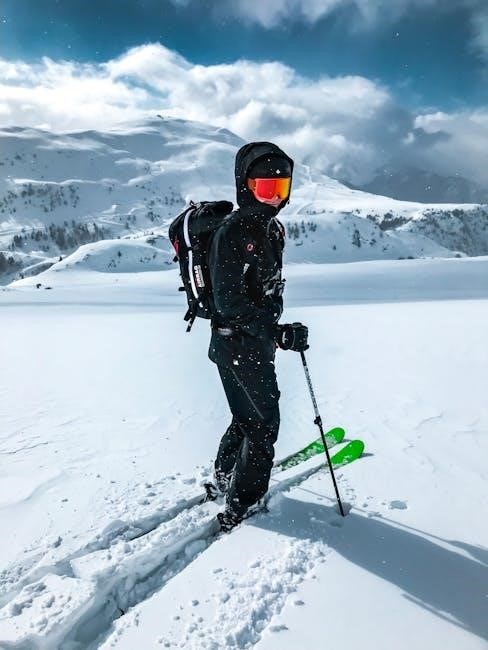
No Responses